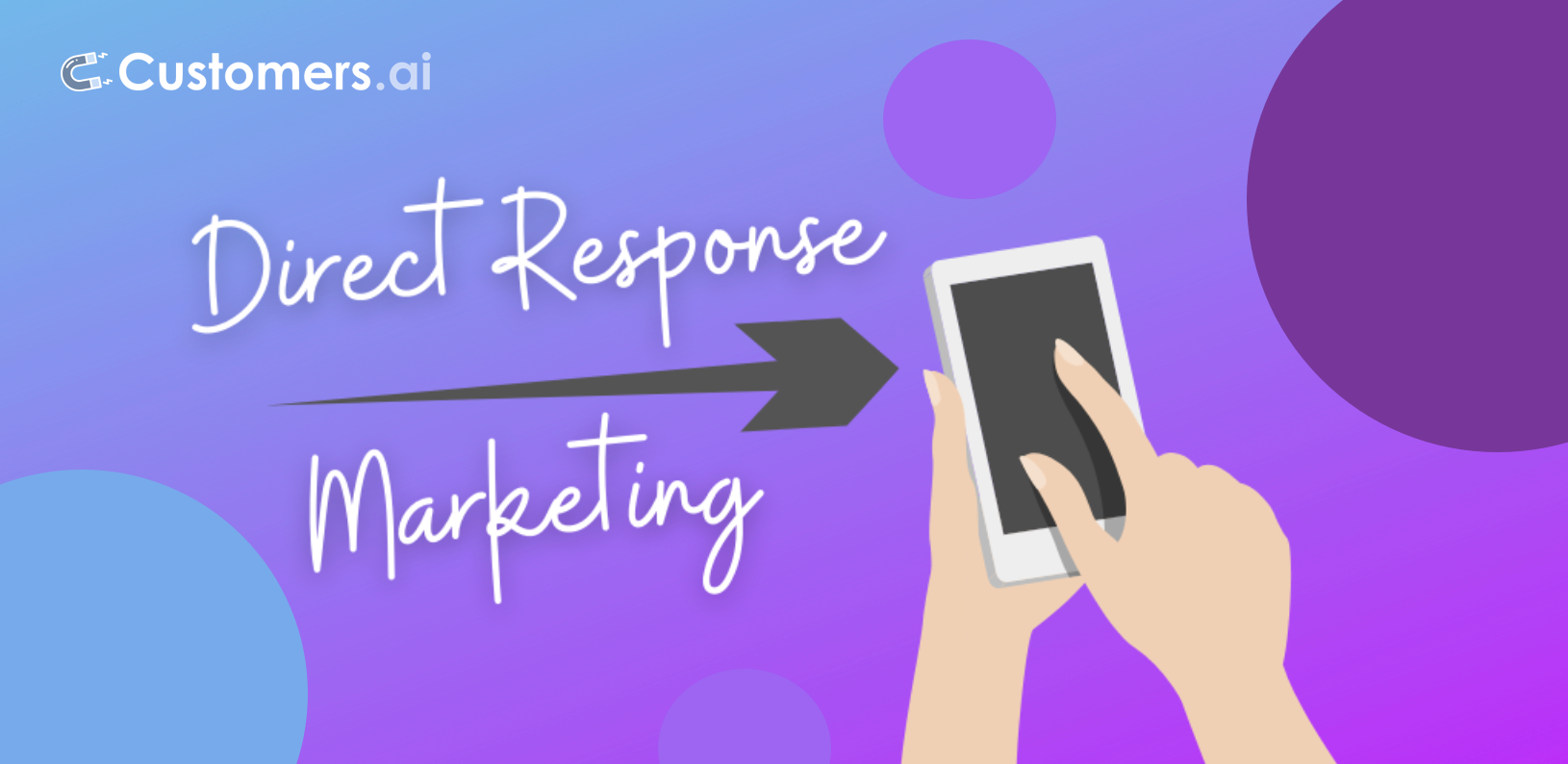When most people think of advertising, they think of massive campaigns by brands like Nike, Microsoft, or Starbucks. Those campaigns are very creative, emotional, and larger than life. Most of all, those brands pull customers in and leave a lasting impression.
If that’s your idea of marketing, as a small business, it can be a bit overwhelming.
So, instead of trying to take on the big brands, you need a different approach. You need to create marketing that drives action today.
Which brings us to direct response marketing.
Direct response marketing is all about making things happen now. It packages the value proposition and call-to-action all in one to take a prospect from consideration to decision faster.
In this article, we will cover all there is to know about direct response marketing, including:
- What is direct response marketing?
- Direct response marketing vs. brand marketing
- How to run a successful direct response marketing campaign
- Direct response marketing channels
- The benefits of direct response marketing
- Developing a direct response marketing strategy
- Direct response marketing best practices
- Direct response marketing strategies & examples
- Measuring direct response marketing campaigns
- Future trends in direct response marketing
- Direct response marketing FAQs
What is Direct Response Marketing?
Direct response marketing is designed to elicit an instant response by encouraging prospects to take a specific action.
Direct response advertisements must trigger immediate action from prospects since the goal is to generate leads quickly. In contrast to traditional marketing, which aims to raise brand awareness and promote brand image long term, direct response marketing shows immediate ROI.
Marketers can leverage direct response on any number of channels, including TV, print, radio, email, digital, and social media.
The purpose of direct response marketing is to send customers targeted messages that drive a specific action – buy a product, read your marketing content, subscribe to a newsletter, refer-a-friend, or any relevant business goal.
Direct Response Marketing vs. Brand Marketing: Understanding the Difference
Let’s clear up one of the biggest marketing misconceptions: direct response marketing and brand marketing are not the same thing. While both aim to grow a business, they go about it in totally different ways, and understanding this distinction is key to making the most of each strategy.
Direct Response Marketing is all about immediate action. Think of it as the “do this now” type of marketing. It’s designed to get people to respond right away—whether that’s clicking a link, signing up, or making a purchase.
You’ll see it in ads that have a clear call-to-action (CTA), like “Shop Now” or “Sign Up Today.” This approach is focused on measurable results and short-term wins, making it ideal for businesses that want a quick return on their marketing investment.
Brand Marketing, on the other hand, is the long game. This type of marketing is more about building recognition, trust, and a strong reputation over time. Instead of urging people to take immediate action, it’s about leaving a lasting impression.
Think of Nike’s “Just Do It”—it doesn’t ask you to buy anything right then and there, but it plants a powerful image of the brand in your mind. Brand marketing aims to build an emotional connection and loyalty so that, eventually, people choose your brand over competitors when they’re ready to buy.
Why It’s Important to Know the Difference:
If you’re always focused on short-term wins, you might miss out on the loyalty that comes with a solid brand. Conversely, if you only work on your brand image, you may lose out on quick conversions that could fuel growth right now.
For most businesses, a balance of both works best: use direct response to drive immediate sales and brand marketing to build a foundation for long-term growth.
Understanding this balance can help you target the right goals with the right tactics and avoid spreading your marketing efforts too thin.
How to Run a Successful Direct Response Marketing Campaign
There are a handful of different components that make up a successful direct response marketing campaign. These include:
- Specific Offers: Creating offers that prompt customer action
- PersonalizedHeadlines and Copy: Crafting persuasive content
- Clear Calls to Action: Designing ads that demand and facilitate a response
- Sense of Urgency: Use FOMO to drive responses to your ads
- Trackability and Measurability: Tools and techniques for monitoring ad performance
- Multi-step, Short-term Follow-up: Engaging leads post-response
Let’s dive deeper into these direct response advertising techniques to understand what makes them successful:
Specific offers
Direct response marketing is aimed at targeted prospects and their specific problem or interest.
A direct response marketing campaign only works if you make a specific offer. You’re not asking people to buy just one of your products. Instead, you’re asking them to buy a specific product.
Additionally, it’s very common to add a discount or other promotion to sweeten the deal and encourage conversions. Without a tempting offer, a direct marketing campaign stands little to no chance to succeed.

Other examples to increase conversions in your direct response campaigns include time restrictions, giveaways, and information highly sought out by your target audience. The more you refine your offer, the lower your CPA (cost per acquisition) will be.
Personalized Headlines and Copy
While it may be tempting to target a super-large audience, direct response marketing works best when you have a specific buyer persona in mind. Take this top Facebook ad hack for example, where you can boost CTR (click-through-rates) significantly by targeting unrelated interests: “Life took me to England but I’ll always be an Arizona girl.”

Look at the comments, they’re comical. People can’t even believe they were served an ad so specific to their background.
But this is nothing sinister. It’s actually been coined the term, “Inverted Unicorn Facebook Ad Targeting Method.”
If you think about it, you know that you can target women, and you know that you can target people who live in the UK, right?
Then, you may also know that you can target by behaviors, such as recently moved.
Another great example of a highly-targeted ad comes from mattress companies. In the early days of Facebook ads, one mattress company realized that you could target recently divorced adults. If someone needs to move out of the house, chances are they’ll need a new mattress sleep on, right?
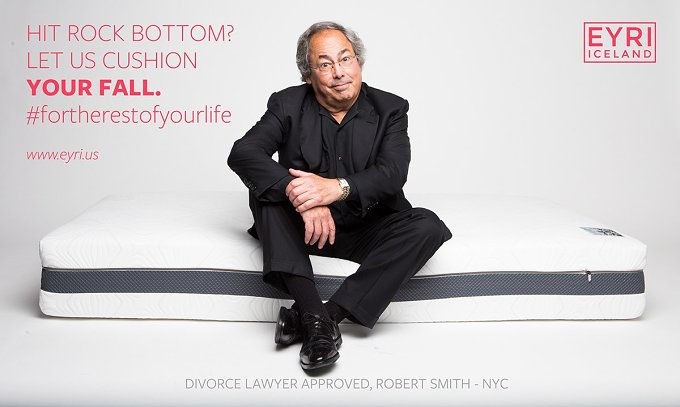
So, if your product and offer are custom-tailored to a persona, you’ll get more interest from the audience and generate more sales. Simple as that.
This doesn’t mean that you have to neglect other buyer personas. It simply means that every direct response marketing campaign you run should focus on a specific buyer persona.
However, you can also take more detailed information from your buyer personas into account. These details could include income, gender, profession, geographical location, and more.
Clear Calls-to-Action
Having a clear CTA is of paramount importance to most marketing campaigns. And a direct response ad should always demand an immediate response with a clear call-to-action that compels the prospect to take action now.
That’s why you need a dedicated lead generation tool for each campaign.
When a prospect responds via a lead capture form, it’s important to collect enough contact information to continue nurturing them through your sales funnel. But, to reduce friction, only ask for what’s appropriate at that stage of the funnel.
A good CTA should include the following:
- A strong command verb to start your CTA, such as “shop,” “subscribe,” or “find out how…”
- Words that provoke emotion or enthusiasm, such as “plan your dream vacation today!”
- Take advantage of FOMO – “fear of missing out”
- Numbers whenever possible, such as “25% off,” or “Free 1-day shipping.”
Creating a Sense of Urgency
Without a deadline or expiration date, your offer becomes far less tempting.
Naturally, consumers will assume that they can return and take advantage of the offer at any time. Since they lead busy lives, those consumers will likely forget altogether. Which isn’t good for business.
Make it clear that your offer extends only for a limited time and that failing to respond immediately could result in the loss of the offer. It’s this fear of missing out that drives direct response marketing.
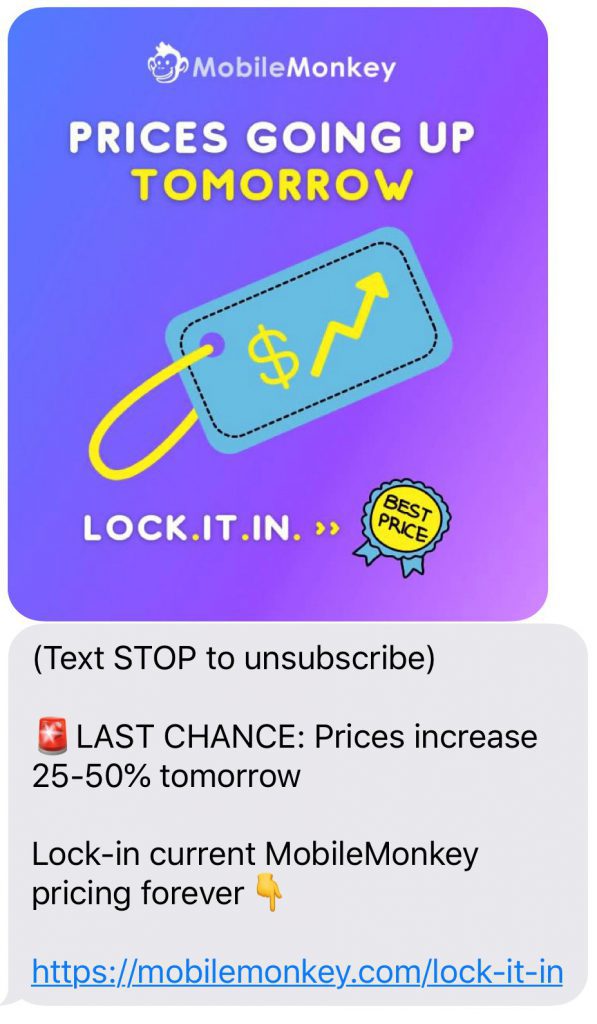
Trackability and Measurability
Shockingly, less than 30% of small businesses use any kind of website analytics or UTM tracking. That won’t work for direct response marketing.
Direct response marketing thrives on tools like Google analytics and long, custom URLs.
Through UTM codes, specific phone numbers, and unique email addresses, it’s easier to get an accurate ROI on your direct response marketing campaigns.
The measurability of direct response also makes it easier to segment your audience and create more customized campaigns over time.
And as a business owner or director of marketing, you want to know who signed up for what and why.
But if you don’t track and measure your outcomes, you can’t confidently say whether your direct response campaigns are working or not.
Multi-step, Short-term Follow-Up
Prompt acknowledgment of a lead’s response (thank you email or message) ensures customers feel they are valued.
After the initial follow-up, you want to engage leads with educational content like guides or webinars, making sure they are tailored to their interests and relevant.
The timing of these follow-ups needs to be strategically spaced to maintain interest without overwhelming them and giving them a clear way to move along the buyer’s journey.
Here’s an example – an online educational platform engaged a potential learner interested in a digital marketing course.
They began with an immediate thank-you email, followed by educational content on digital marketing careers, and then a personalized offer for a free trial class.
The sequence culminated in a feedback request and a final email offering a limited-time discount on the course, effectively nurturing the lead and encouraging enrollment.
The key – staying in front of the customer and staying relevant to their needs.
The Top Direct Response Marketing Channels
There are a number of channels available for direct response marketing, each offering its own unique way to reach and engage your audience. Let’s dive into some of the most common direct response marketing channels:
- Digital and Social Media Ads: Platforms like Facebook, Instagram, and TikTok are goldmines for direct response marketers. They offer advanced targeting options and interactive formats to capture the attention of a diverse audience, enabling marketers to craft personalized and visually engaging ads.
- Email Campaigns: Email remains a powerful tool for direct response marketing, allowing for personalized, timely communication. Strategies here focus on creating urgency and relevance through customized content, driving recipients towards immediate action.
- Pay-Per-Click (PPC) & Paid Social Ads: Paid Ads are instrumental in placing your message in front of users actively searching for related services or products. This channel excels in capturing high-intent traffic, turning searches into valuable leads or sales.
- Television and Connected TV Ads: By blending traditional TV formats with the interactivity of connected TV, this channel offers a wide reach while allowing for more targeted and measurable direct response campaigns. It’s effective for engaging audiences in a familiar yet innovative way.
- SMS (Text Messaging) and Direct Mail: This combination of digital and physical outreach balances immediacy with tangibility. SMS offers instant, personal communication, while direct mail provides a physical touchpoint that can stand out in a digitally crowded world.
- Phased Campaigns: This approach involves nurturing potential customers through various stages of engagement. Each phase is designed to build interest and guide the audience towards the final action, often using a mix of channels and message types.
- Recruiting through Direct Response: Beyond selling products, direct response tactics are also effective for recruitment purposes, such as driver recruitment in rideshare companies. These campaigns focus on clear, compelling calls to action that resonate with potential applicants.
- Refer-a-Friend Programs: Leveraging the power of word-of-mouth, refer-a-friend programs encourage existing customers to become brand advocates. These programs are great for building community and trust, offering rewards that incentivize both referrers and new customers.
AI-Powered Advertising
How to Unlock AI and Lead Capture Tech for 10X Return on Ad Spend


HOSTED BY
Larry Kim
Founder and CEO, Customers.ai
The Benefits of Direct Response Marketing
There are many benefits to direct response marketing. Here are just a few of them:
1. Create a Direct Line of Communication with Prospects
In contrast to brand advertising, which uses more broad targeting to build brand awareness, direct response advertising is highly personalized, conveying specific information about how the product or service can help the prospect.
This level of personalization enables prospects to feel more comfortable and connected to the brand and the offer, inviting them to communicate with the company openly.
2. Provide a Great ROI (return on investment)
Although brand advertising can be extremely effective, it’s also costly and time-consuming to pull off successfully. While this isn’t an issue for major brands with limitless advertising budgets, it’s not as easy for smaller businesses with fewer means.
The few times they run their brand ad is nowhere near enough to compete with those other large brands, and the result is being drowned out and producing little to no ROI.
On the other hand, direct response marketing can be useful regardless of your budget. As long as you’re paying for clicks, you stand an equal chance of generating a high ROI.
3. Produce Easily Trackable and Measurable Results
By tracking how many conversions you’ve generated from each direct response campaign, and where those conversions originated, you can measure the overall success of each ad.
Then, optimize or remove those campaigns that aren’t producing a positive ROI.
4. Build and Strengthen Relationships with Customers
Communication isn’t just used at the start of the buyer’s journey. Use direct response marketing throughout the entire customer journey in order to improve the purchasing experience, such as upsells, drip campaigns, free offers, and more.

See Who Is On Your Site Right Now!
Get names, emails, phone numbers & more.
Try it Free, No Credit Card Required
Developing a Direct Response Marketing Strategy: How to Get Started
Creating a successful direct response marketing strategy is all about designing a path that leads people to act right now—whether that’s clicking, signing up, or making a purchase.
Here’s a straightforward approach to building a direct response strategy, with some how-to’s and examples to get you started.
1. Define Clear, Action-Oriented Goals
- First things first: be super clear about what you want your audience to do. Do you want them to sign up for a free trial, download an ebook, or complete a purchase? Your goal should be as specific as possible.
- Example: Instead of saying, “Increase conversions,” try “Get 200 people to sign up for our newsletter this month.” The more specific, the easier it is to craft an action-focused campaign.
2. Know Your Audience Inside and Out
- Direct response marketing works best when you understand what motivates your audience. This means segmenting them based on behavior, demographics, or interests and tailoring your message to resonate with each group.
- Example: If you’re targeting young professionals interested in financial planning, your message might focus on “start planning today for a secure future,” tapping into their forward-thinking mindset.
3. Craft a Compelling Offer They Can’t Refuse
- The offer is the heart of direct response marketing. It’s got to be enticing enough to make people want to act immediately. Think limited-time discounts, exclusive access, or something free with purchase.
- Example: A skincare brand could offer a “Get a free travel-size product with any purchase over $30—today only!” This creates a sense of value and urgency, nudging customers to make a decision.
4. Use a Strong Call-to-Action (CTA)
- Your CTA should be clear, direct, and placed in a way that’s easy to see. Avoid vague phrases like “Learn More” and go for something punchy and actionable.
- Example: Instead of “Explore our products,” try “Get Yours Now!” or “Claim Your Discount Today.” This way, your CTA leaves no room for hesitation—it’s all about moving people toward that next step.
5. Create a Sense of Urgency
- Nothing spurs people to action like the idea of missing out. Adding urgency—like limited-time offers or countdowns—can give people that extra push.
- Example: An online course provider could include, “Sign up within the next 48 hours to get 50% off!” This adds a time-sensitive element that keeps prospects from putting it off until later.
6. Set Up Tracking and Measure Your Success
- Direct response marketing is data-driven, so make sure to track your campaign’s performance with tools like Google Analytics, Facebook Pixel, or email tracking. Monitor key metrics such as click-through rate (CTR), conversion rate, and cost per acquisition (CPA).
- Example: If you’re running a social media ad campaign, you might find that ads with video content perform better. Use this data to optimize future campaigns with similar formats.
7. Test, Refine, and Scale Up
- Testing isn’t optional in direct response marketing—it’s essential. Try different CTAs, offers, or audience segments to see what works best, then double down on the winning elements. A/B testing is your best friend here.
- Example: A fitness brand could test two versions of an ad—one that highlights a “10% off your first order” offer and another that promotes “Free shipping on orders over $50.” By comparing conversion rates, they can see which offer resonates more and refine their messaging accordingly.
By following these steps, you can build a direct response strategy that’s set up for success. Each component works together to encourage immediate action and, importantly, helps you make data-informed adjustments for even better results over time.
Direct Response Marketing Best Practices: Tips for Getting the Best Results
Want to make sure your direct response marketing efforts get the best results? Here are some tried-and-true best practices to guide you. These tips will help you get those clicks, sign-ups, and sales that make direct response campaigns so effective.
1. Be Crystal Clear with Your Messaging
In direct response, clarity is everything. Your audience should know exactly what they’re getting and what action you want them to take—no guesswork required.
Example: Instead of saying “Unlock Your Potential,” try something more specific, like “Sign Up for Weekly Marketing Tips to Grow Your Business.” The more specific you are, the better your message will land.
2. Focus on One Goal per Campaign
Each direct response campaign should have a single, focused goal. Trying to get people to do too many things at once dilutes your message and decreases the likelihood of any one action being taken.
Example: If your campaign’s goal is to get more free trial sign-ups, don’t muddy the waters by also asking people to follow your social media channels. Stick to one clear call-to-action.
3. Use Attention-Grabbing Visuals and Headlines
People are visual by nature, so strong visuals and headlines are key to pulling them in. Use bold colors, eye-catching images, and headlines that make people stop and pay attention.
Example: In an email campaign, your subject line could say, “Get 50% Off Today Only—Don’t Miss Out!” With an image of the product and a countdown timer, you’re already halfway to grabbing their attention.
4. Personalize Your Message Whenever Possible
Personalization is proven to boost response rates. Address people by their name, mention their recent interactions, or customize the offer based on their behavior.
Example: For an email list segment that browsed winter gear but didn’t buy, try “Hey [Name], it looks like you’re interested in staying warm this winter—here’s 20% off on jackets just for you!”
5. Create a Strong Sense of Urgency
Urgency drives action, so don’t be afraid to add time limits, limited availability, or countdown timers to your campaigns. When people think they might miss out, they’re more likely to act fast.
Example: “Only 5 spots left—claim yours now!” or “Flash Sale Ends at Midnight!” both create the kind of FOMO that drives clicks and conversions.
6. Highlight Benefits Over Features
In direct response, people care more about how your product or service will improve their life, not just what it does. Focus on benefits that appeal to emotions or solve specific problems.
Example: Instead of saying, “Our software includes customizable dashboards,” try “Easily track your sales and get insights that help you grow revenue faster.” Benefits speak directly to your audience’s needs.
7. Test and Tweak Regularly
Direct response marketing isn’t a “set it and forget it” type of strategy. Test your campaigns to see what’s working (and what isn’t). Try different headlines, CTAs, images, and even target audiences to see what brings the best results.
Example: Run two versions of a Facebook ad—one with a discount offer and another with free shipping. Track the results, and go with the one that brings the highest conversion rate.
8. Follow Up Quickly with Leads
Direct response doesn’t end once someone responds. Following up quickly, especially for leads, keeps your brand top of mind and increases the likelihood of conversion.
Example: If someone fills out a form to get a free demo, make sure they receive a follow-up email within an hour. Adding a short “thank you” message with a CTA to book a time for their demo keeps the momentum going.
9. Make It Easy to Take Action
Don’t make people jump through hoops to respond. Remove unnecessary steps, make CTAs prominent, and keep your forms short and simple.
Example: If you’re asking for sign-ups, keep it to essential info—name and email. The fewer fields they have to fill out, the higher your conversion rate.
10. Measure What Matters and Optimize for It
To know if your direct response marketing is working, keep track of key metrics—like click-through rate, conversion rate, and return on investment. Use these insights to adjust and improve future campaigns.
Example: Let’s say you see a high click-through rate but low conversions. This could mean your landing page needs tweaking, maybe with a clearer CTA or more compelling copy.
When done right, direct response marketing can drive powerful results. These best practices can help you fine-tune your campaigns and boost engagement by making it easy—and irresistible—for people to act.
See the Visitors Hiding on Your Site
Book a demo of Customers.ai’s U.S. website visitor identification, customer journey insights and remarketing platform to skyrocket conversions and sales.
Direct Response Marketing Strategies & Examples
So, what direct response marketing channels are the most effective?
Here are 7 super effective direct response marketing examples that you can try today:
#1. Direct response advertising
You can dramatically boost conversion rates by using Facebook Messenger for business. It’s one of the leading direct response channels with 80% open rates and 56% CTR on average.
An emerging favorite Facebook ad is called the click-to-Messenger ad because of a feature called instant lead capture.
As soon as someone clicks the CTA button on the ad, they’re sent to your brand’s Messenger experience.
So when they engage with your brand in Messenger, they become a contact with captured lead data and the ability to send follow-up messages.
Use Customers.ai’s Facebook Messenger funnel builder to automate the conversation you have with a new lead. This trick can infinitely scale your lead gen efforts because you don’t have to manually qualify and collect lead data.
Use the Click-to-Messenger Ads tool in Customers.ai to set up a Facebook Messenger ad with automated lead capture.

Ask qualifying questions and create lasting connections with new leads with a visual chatbot builder that connects directly to your Facebook ad.

Customers.ai customers are cutting their CPL (cost per lead) in half or more with this engaging ad format. See what I mean in this Facebook Messenger ad case study.
#2. Direct response example: Referral marketing campaigns
Referrals are another extremely powerful direct response strategy that can boost your conversions. People are happy to talk about their experiences with your company, but sometimes they need a push.
Plus, customers referred to you by a friend are 37% more likely to stick around.
One great referral program that I’ve come across recently is with the Robinhood app. Robinhood is a no-fee financial market investment app. When you refer a friend to Robinhood, both you and your friend get one free stock.
The offer is pretty enticing when you see that you have a 1 in 250 chance of getting stocks like Apple and Berkshire Hathaway.
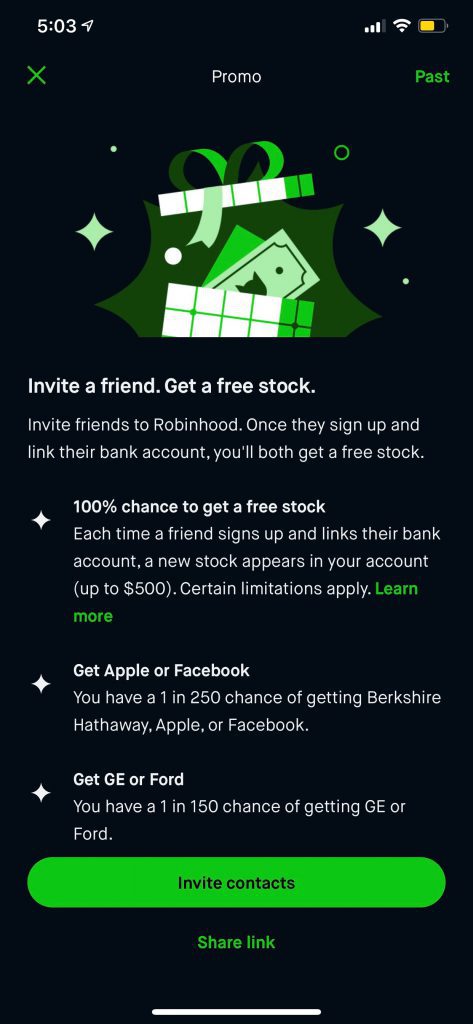
Word of mouth is the most powerful influence your online store can have going for it.
In fact, a study by Nielsen reported that 92% of consumers believe suggestions from friends and family more than advertising.
Now, if you’re looking for tools that help your direct response campaigns get referrals, check out ReferralCandy. It’s a referral generating platform that gets your customers to tell their connections about your product and service. And it does so by incentivizing customers to make product suggestions on your company’s behalf.
For example, when a customer buys something from your ecommerce store, they automatically get a referral code that they can easily share with their friends and family. And when a friend of theirs makes a purchase with that referral code, two things happen:
- The friend gets a discount on their purchase, and
- The referrer earns rewards from your online store.
You can choose to reward the customers that refer your business with either coupons or cash.
For more tools and referral strategy tips, check out these 6 viral marketing tools proven to drive traffic and leads fast.

See Who Is On Your Site Right Now!
Get names, emails, phone numbers & more.
Try it Free, No Credit Card Required
#3. Direct response marketing example: Run an online contest
Giveaways and contests are one of the best ways to quickly increase engagement on Facebook. And the best way to run a Facebook contest is via Messenger.
Running a Facebook giveaway with a Messenger bot is an effective tactic for generating new leads, getting more fans, and expanding your network reach.
But contests using a chatbot to do the heavy lifting have even more upside:
- Instant lead and data capture
- Low-friction for user participation
- Automated follow-ups and management
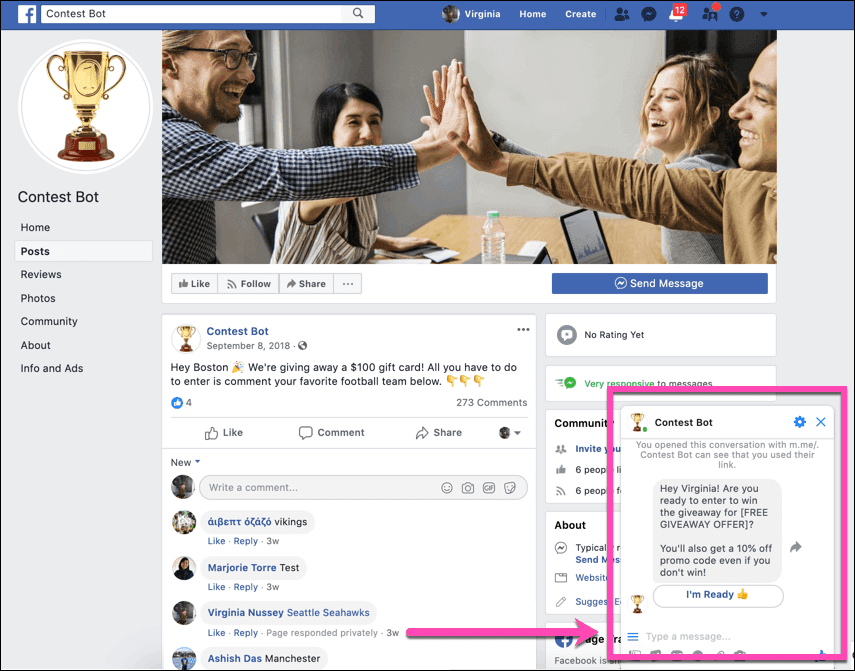
Furthermore, running a Facebook contest is an opportunity for lots of innovative ideas. And that’s because you can get creative with the rewards, prizes, and incentives you decide to offer.
Keep in mind that it’s important to focus on aligning rewards with your brand and the giveaway you’re running. Giving away an Amazon gift card only provides an incentive to get a gift card, which has nothing to do with your brand.
Instead, the prizes you giveaway should be things that your target audience would like to receive.
Check out these 10 Facebook Messenger bot contest examples for more ideas!
#4. Direct response marketing example: Drip marketing campaigns
One reason tracking customer behavior is so important in direct response marketing is because it may take a few actions before the customer is ready to buy.
That’s why you don’t need to focus all your time and attention on the bottom of your funnel.
While direct response is about driving a specific action with a single CTA, that action can change from one phase of a campaign to the next.
Instead, you can make your chat visitor aware of some of your non-sales content as well. Think of it like having a casual conversation with someone about your business, without pushing sales at all.
Customers.ai’s many marketing automation tools include drip campaign features for Facebook, web chat, SMS, and other popular platforms.
The drip campaign feature allows you to set up a sequence of messages delivered at specified intervals.
Marketers rely on drip campaigns to:
- Welcome and onboard customers
- Keep leads engaged with the brand
- Activate the use of sophisticated solutions
- Leverage automation to communicate at scale
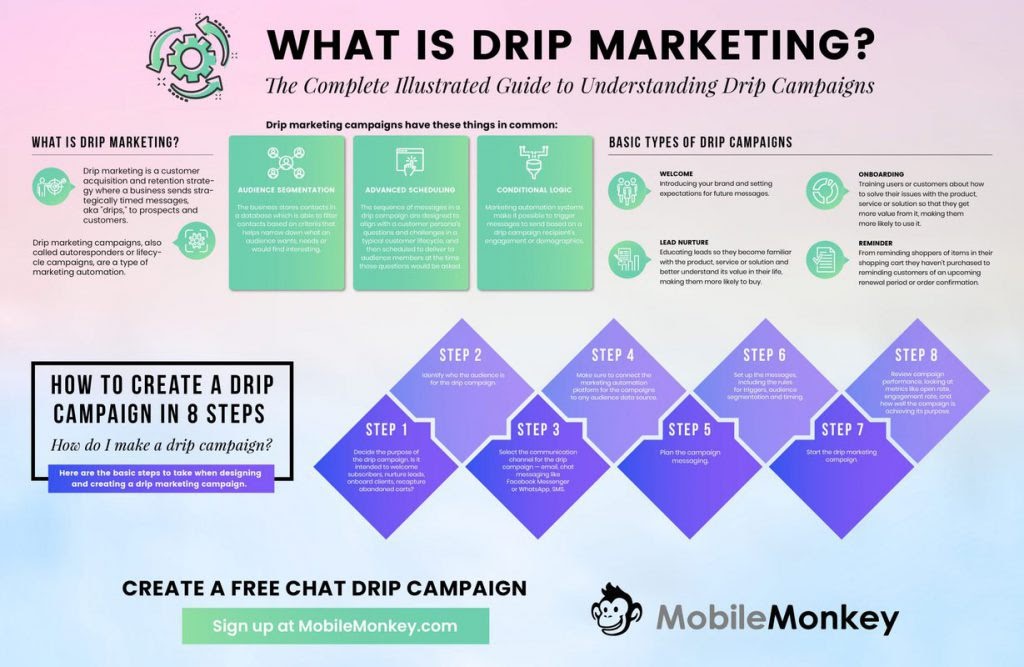
Drip campaigns for email aren’t new. But chatbots bring drip campaigns to the next level with higher open rates and engagement rates.
Plus, it’s super easy to do with a free chatbot in Customers.ai.
Creating a drip campaign is something you only need to set up once. And drips are a powerful tool to keep customers engaged as you continue to send them valuable, relevant content.
Learn more about chatbot drip campaigns.
#5. Direct response marketing example: Offer up free stuff
Free offers are by far one of the best direct response marketing campaigns to run. For example, what if there was a free tool you could use to fully automate lead capture on Facebook?
Well, here’s a real-life example of that free offer!
Customers.ai has built a free tool that allows you to get email addresses from Facebook. And this free offer is great because, with just a few clicks, you can turn your Facebook fans into leads. These are people who follow and like your company’s page on Facebook.
And you capture their names, emails, and phone numbers – automatically!
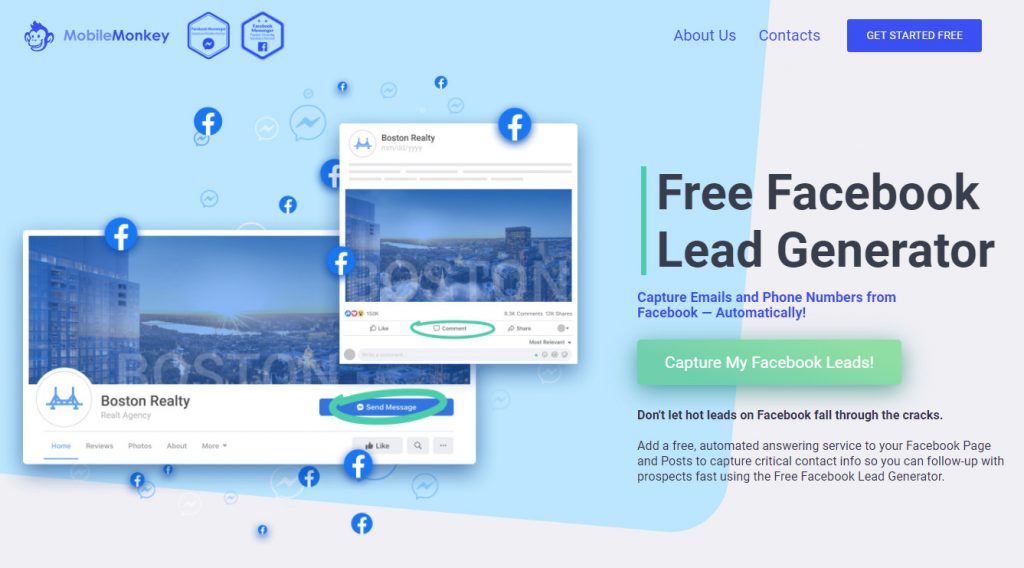
Here’s how the free Facebook Lead Generator works:
- Fans and prospects message your Facebook Page and comment on Posts.
- Customers.ai auto-replies in Messenger to collect emails and phone numbers.
- Then Customers.ai sends you a daily email report containing all your new leads.
- Use Customers.ai to re-engage your leads at any time.
So, don’t let hot leads on Facebook fall through the cracks.
Add a free, automated answering service to your Facebook Page and Posts to capture critical contact info so you can follow-up with prospects fast using the Free Facebook Lead Generator.
#6. Direct response marketing example: Text message marketing
Text marketing is an increasingly popular marketing strategy. The channel sees an average open rate of 98% and is one of the cheapest, easiest ways to reach anyone, anywhere, at any time.
Here a few SMS marketing statistics that tend to surprise many digital marketers:
- Text messages have a 98% open rate.
- Marketers see 6-8X the engagement when comparing SMS vs email.
- Response rates of 45% and an average response time of 90 seconds.
Reaching out proactively and engaging with segments of your audience is effective in moving prospects to the bottom of your sales funnel. And one of the most powerful proactive channels is text message marketing.
For example, after opting-in new SMS subscribers with an SMS Keyword, you can send bulk text messages to that audience with announcements, news, and deals.
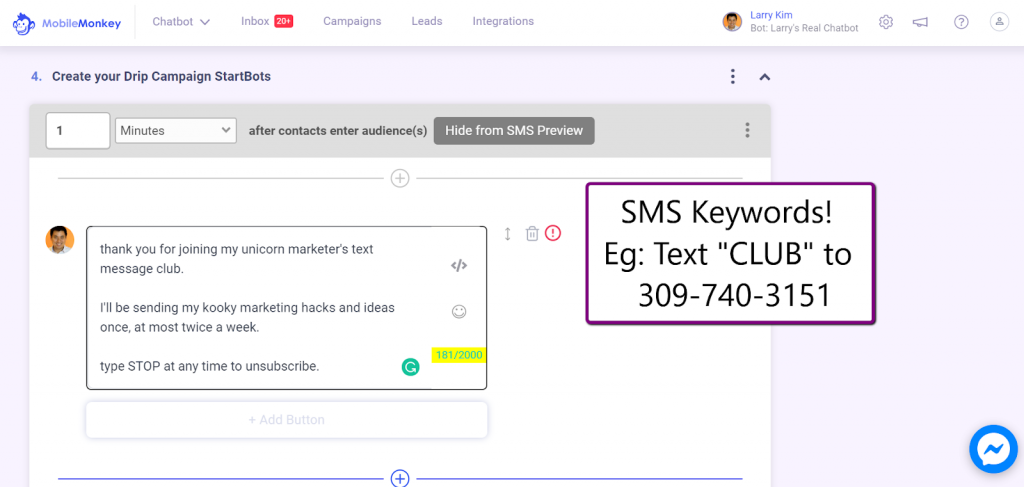
Check out these 10 super effective SMS marketing tips and best practices for more ideas!
#7. Direct response marketing example: Upselling strategies
According to GrooveHQ, The probability of a new prospect buying is about 5-20%, but the probability of successfully selling again to an existing customer jumps to 70-90%.
And you can upsell products online using chatbots. Whether it’s a Facebook Messenger bot, an SMS bot, or a live chat bot on your website, you’re creating new contacts with every lead and customer who starts a conversation.
Next it’s time to let your subscribers know about products and offers, sales, and promos.
Here we’re going to build a popular and effective chatbot use example: a sale or promo bot blast.

In the screenshot, notice how scarcity is used by emphasizing that the sale is running on a specific day. People want more of what they think they can’t have for much longer!
This creates a sense of urgency without having to give away any discounts or freebies. Urgency can be key in a direct response campaign because it encourages action now.
See how to sell more online using chatbots here!
Measuring Direct Response Campaign Success: Metrics and Challenges
Measuring the success of a direct response campaign isn’t just about tracking clicks or counting sign-ups—it’s about understanding how effective your campaign was in driving immediate action and achieving a positive return on investment. Here’s how to measure direct response success and some common challenges marketers face along the way.
1. Key Metrics to Track for Direct Response Campaigns
Conversion Rate: This is the percentage of people who completed the desired action, whether that’s signing up, making a purchase, or clicking a link. A high conversion rate is a strong indicator that your messaging, offer, and CTA are resonating. Ex: If 500 people clicked on your ad and 50 signed up, you have a 10% conversion rate. Tracking this metric over time helps you see what’s working and where you might need to make adjustments.
Click-Through Rate (CTR): This measures the percentage of people who clicked on your ad or link after seeing it. A high CTR usually means your ad copy or visuals are catching attention and prompting curiosity. Ex: In email campaigns, the CTR can help you understand if your subject line and preview text were enticing enough to get people to read more.
Cost Per Acquisition (CPA): CPA measures how much you’re spending to get each new lead or sale. Keeping CPA low is essential for maintaining profitability, especially in paid ad campaigns. Ex: If you spent $1,000 on a Facebook ad campaign and got 100 new sign-ups, your CPA is $10. This metric can guide budget adjustments or campaign targeting tweaks.
Return on Ad Spend (ROAS): ROAS shows how much revenue you’re generating for every dollar spent on advertising. The higher your ROAS, the better the campaign’s profitability. Ex: If you spent $500 on ads and made $2,000 in sales, your ROAS is 4:1, meaning you made $4 for every $1 spent. This metric is critical for paid media campaigns where budget efficiency matters.
Lead Quality: It’s not just about the number of leads; it’s about their quality. High-quality leads are more likely to convert into paying customers. To measure lead quality, track conversion rates from specific leads or calculate the average order value from campaigns. Ex: If one campaign leads to more high-ticket sales than another, this indicates stronger lead quality, even if total leads are lower.
2. Common Challenges in Measuring Direct Response Success
Attribution Complexity: In today’s multi-channel world, it can be hard to pinpoint which part of your campaign drove a specific action. If someone clicks on a social ad but completes the purchase after an email reminder, which touchpoint gets credit?
Solution: Use multi-touch attribution models and track each touchpoint to understand the customer journey. Attribution tools can help, but remember that no model is perfect—use insights as a guide rather than the gospel.
Lagging Conversion Data: Some direct response campaigns, like free trial sign-ups, might not show immediate sales impact. This lag makes it tricky to measure success in real-time.
Solution: Track interim metrics like trial engagement or add-to-cart rate to gauge whether your leads are progressing toward conversion, even if final sales data isn’t in yet.
Budget Constraints on Testing: Testing is key to improving campaign success, but smaller budgets can limit the scope of testing for different CTAs, audiences, or creatives.
Solution: Start small by A/B testing key elements—like CTAs or ad visuals—and focus on the areas that could have the most impact. Gradually scale up as you identify winning strategies.
Measuring Soft Metrics vs. Hard Conversions: Direct response campaigns often focus on measurable actions, but sometimes the immediate response isn’t the final purchase. For example, a newsletter sign-up is valuable, but it doesn’t directly equate to revenue.
Solution: Establish “micro-conversions” as benchmarks (like time on site, email sign-up, or add-to-cart actions) that lead to bigger wins. This lets you track value beyond hard sales.
Ad Fatigue and Declining Engagement: If you’re running direct response ads frequently, audiences may start ignoring them, which can lead to reduced CTR and conversion rates.
Solution: Refresh your creatives regularly and experiment with new angles, visuals, or even formats (e.g., switching from static ads to short videos). Testing different creatives can help combat ad fatigue and keep your audience engaged.
3. How to Tackle These Challenges and Optimize Campaigns
• Combine Real-Time and Delayed Data: Real-time metrics give you immediate feedback, while longer-term metrics (like lifetime value) show how initial actions translate into overall success.
• Use Segmentation for Clearer Insights: Segment your audience to see if certain groups respond better than others. This can provide insights into which customer types to focus on and help refine your message.
• Iterate Based on Learnings: Direct response marketing thrives on data, so be ready to tweak, adjust, and optimize based on performance. If something’s working, double down on it. If not, pivot quickly.
By focusing on key metrics and understanding the potential challenges, you can get a clearer picture of what’s driving your campaign’s success (or where improvements are needed). With these insights, you’ll be better equipped to create campaigns that deliver more value and stronger ROI.
Future Trends in Direct Response Marketing
As we look towards the future of direct response marketing, it’s clear there are both exciting opportunities and significant challenges. Let’s look at a few key trends facing the direct response marketing space:
A Cookieless Marketing World
With Apple throwing cookies out the door years ago and Chrome deprecating them as we speak, the days of third-party cookies are effectively over.
This calls for a new focus on first-party data.
Marketers now need to get creative and more strategic about how they gather and use data, ensuring their campaigns remain relevant and effective in this new era.
Brand Loyalty Above All Else
People want to feel good about their purchases. They want to feel appreciated and like the company gets them. They want to be loyal.
To create loyal customers, businesses must figure out how to build real connections.
Part of this means ensuring your brand’s message is consistent across all platforms. It means creating a narrative that resonates with your audience, makes them feel good, and transforms one-time buyers into lifelong fans.
Balancing Marketing with Privacy
As technology gives us more ways to reach customers, it also raises important questions about privacy and ethics.
Marketers have to find the right balance between personalization and respecting consumer data privacy.
Navigating this landscape carefully is key to maintaining trust with your audience and keeping your brand on the right side of regulations.
Direct Response Marketing FTW!
As we wrap up our exploration of direct response marketing, it’s evident that the space is both challenging and rewarding.
The key to success lies in staying adaptable, understanding your audience deeply, and leveraging the latest tools and trends while maintaining ethical standards.
By embracing these principles, marketers can craft compelling campaigns that not only drive immediate results but also build lasting relationships with their audience.
Convert Website Visitors into Real Contacts!
Identify who is visiting your site with name, email and more. Get 500 contacts for free!

See Who Is On Your Site Right Now!
Get names, emails, phone numbers & more.
Try it Free, No Credit Card Required
Important Next Steps
- See what targeted outbound marketing is all about. Capture and engage your first 500 website visitor leads with Customers.ai X-Ray website visitor identification for free.
- Talk and learn about sales outreach automation with other growth enthusiasts. Join Customers.ai Island, our Facebook group of 40K marketers and entrepreneurs who are ready to support you.
- Advance your marketing performance with Sales Outreach School, a free tutorial and training area for sales pros and marketers.
- See what targeted outbound marketing is all about. Capture and engage your first 500 website visitor leads with Customers.ai X-Ray website visitor identification for free.
- Talk and learn about sales outreach automation with other growth enthusiasts. Join Customers.ai Island, our Facebook group of 40K marketers and entrepreneurs who are ready to support you.
- Advance your marketing performance with Sales Outreach School, a free tutorial and training area for sales pros and marketers.
Direct Response Marketing FAQs
Q. How does direct response marketing differ from traditional marketing?
Unlike traditional marketing, which focuses on brand awareness and long-term customer engagement, direct response marketing aims for immediate customer action and measurable responses.
Q. What are the key characteristics of a direct response marketing campaign?
Key characteristics include a clear call to action, measurable responses, targeted messaging, and a sense of urgency to provoke immediate action.
Q. What are some common examples of direct response marketing?
Examples include email campaigns with a clear call to action, online ads prompting immediate purchase, telemarketing, and mailers with response forms.
Q. Why is direct response marketing effective?
It’s effective because it’s targeted, measurable, and designed to elicit specific actions, allowing for quick adjustments and optimization based on response data.
Q. What role does personalization play in direct response marketing?
Personalization is crucial as it increases relevance and engagement by addressing the specific needs and interests of the targeted audience.
Q. How do you measure the success of a direct response marketing campaign?
Success is typically measured by the response rate, conversion rate, and overall ROI of the campaign, tracking how many people took the desired action.
Q. Can direct response marketing be used for customer retention?
Yes, it can be used for customer retention by creating campaigns that encourage repeat purchases or loyalty program sign-ups.
Q. What are some challenges of direct response marketing?
Challenges include standing out in a crowded market, ensuring message precision, and maintaining a balance between persuasion and intrusion.
Q. How has digital marketing impacted direct response advertising?
Digital marketing has expanded the reach and precision of direct response advertising, allowing for more targeted campaigns and real-time tracking of responses.
Q. What is the role of A/B testing in direct response marketing?
A/B testing allows marketers to compare different versions of a campaign to determine which is more effective in eliciting a response.
Q. How important is the call to action in direct response marketing?
The call to action is vital as it directs the consumer exactly what to do next, making it a key element of the campaign’s effectiveness.
Q. What types of businesses can benefit from direct response marketing?
Businesses of all types and sizes can benefit, especially those looking for measurable marketing tactics and immediate customer engagement.
Q. How do you create a compelling direct-response advertisement?
A compelling ad combines a clear, urgent message with a strong call to action and an offer that resonates with the target audience’s needs or interests.
Q. What is the significance of timing in direct response marketing?
Timing is critical as it ensures the message reaches the audience when they are most likely to take action, such as during specific events or seasons.
Q. Can social media be used for direct response marketing?
Absolutely, social media platforms are effective channels for direct response marketing, offering targeted advertising options and instant engagement.
Q. What role does copywriting play in direct response marketing?
Effective copywriting is essential in crafting messages that are clear, persuasive, and motivating, directly impacting the campaign’s success.
Q. How does mobile marketing fit into direct response strategies?
Mobile marketing offers immediate, personalized communication through SMS, app notifications, and mobile-optimized ads, making it a powerful component of direct response strategies.
Q. What are some ethical considerations in direct response marketing?
Ethical considerations include respecting consumer privacy, avoiding misleading claims, and being transparent about the intent and content of the campaigns.
Q. How can direct response marketing be integrated into an overall marketing strategy?
It can be integrated by aligning its goals with broader marketing objectives, using it in tandem with brand-building and content marketing efforts.
Q. What’s the role of urgency in direct response marketing?
Urgency compels the audience to act quickly, often used through limited-time offers or exclusive deals to trigger immediate responses.
Q. How can you use direct response marketing for lead generation?
It can be used for lead generation by creating offers or content that require users to submit contact information, thus capturing leads for future marketing efforts.
Q. What is a good response rate for a direct response marketing campaign?
A good response rate varies by industry and campaign type, but generally, rates above industry averages are considered successful.
Q. How does targeting work in direct response marketing?
Targeting involves identifying and focusing on specific audience segments whose needs and behaviors align with the campaign’s goals, increasing relevance and response rates.
Q. What are some common mistakes in direct response marketing?
Common mistakes include unclear calls to action, lack of personalization, neglecting to test and optimize, and failing to track and analyze campaign performance.
Q. How do you ensure a direct response marketing campaign is legally compliant?
Legal compliance involves adhering to regulations related to advertising, data protection, and consumer rights, ensuring all claims are truthful and privacy is respected.
Q. Can direct response marketing be automated?
Certain aspects, like email campaigns and social media ads, can be automated to improve efficiency, though customization and personal touch remain key.
Q. What impact does customer feedback have on direct response marketing?
Customer feedback is invaluable for refining campaign strategies, understanding audience needs, and improving future marketing efforts.
Q. How do you balance creativity and directness in direct response ads?
Balancing creativity and directness involves crafting messages that are both engaging and clear, using creative elements to attract attention while maintaining a focus on the desired action.
Q. What future trends should direct response marketers be aware of?
Future trends include increased use of AI and machine learning for targeting, growing emphasis on privacy and ethical marketing, and the rising importance of interactive and personalized content.
